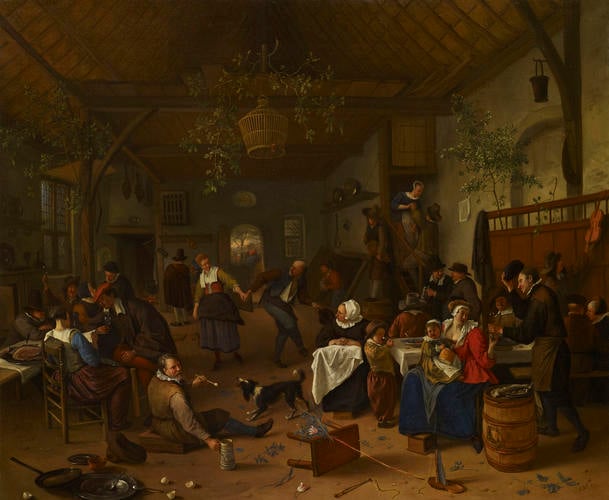Merrymaking in a Tavern with a Couple dancing c.1670
Oil on canvas | 61.7 x 75.1 cm (support, canvas/panel/stretcher external) | RCIN 404813
-
Pieter Bruegel the Elder was still revered in the Low Countries a century after his death in 1569. At this date in his native Flanders artists, like David Teniers, were still creating multi-narrative crowd scenes; in the Dutch Republic on the other hand genre painting tended to concentrate on a closer engagement with up to five or so figures. Works of this kind by Jan Steen are exceptional in the number of figures and in the conscious tribute they pay to Bruegel. They are surely trying to suggest that in some way they treat 'all of human life'.
In this case it is difficult to read the exact circumstances: the space seems large enough to be a hall though peopled like a tavern; it is decorated with branches for some special occasion, like a wedding (though there is no obvious candidates for the happy couple). Amongst the revellers there is a young man going upstairs with a woman to the right, but nothing else to suggest debauchery or vice. Instead there is comic variety: a gloomy drunk sulks under his hat to the extreme left; a gallant one offers the young mother a drink to the right. The old man dances absurdly with a young woman, who moves with shy grace and must be the hostess, as she has keys hanging from a her waist. There seem to be many 'ages of man' here present: baby (with toy drum and boat and a whip to spin a top); boy illicitly tasting liquor; young man with hurdy-gurdy; and finally an old man, who has drunk himself onto the floor as if one move away from the grave. This old man grins at us as he clutches his beer pot and seems to represent some kind of philosophical wisdom. Like the equivalent figure in CW 193, 405611, he may be intended as a Dutch Diogenes, barking like the dog next to him (the Greek for dog being the word which gives us Cynic).
This is the kind of multi-figure comedy and deep barn space which David Wilkie sought to emulate with his Blind Man's Buff and Penny Wedding, both painted for George IV (in 1812 and 1818 respectively).
Signed lower right: 'JSteen'Provenance
Purchased by George IV from Sir Thomas Baring as part of a group of 86 Dutch and Flemish paintings, most of which were collected by Sir Thomas’s father, Sir Francis Baring; they arrived at Carlton House on 6 May 1814; recorded in the Anti Room, Ground Floor, at Carlton House in 1819 (no 140); in the Picture Gallery at Buckingham Palace in 1841 (no 165)
-
Medium and techniques
Oil on canvas
Measurements
61.7 x 75.1 cm (support, canvas/panel/stretcher external)
78.8 x 91.0 x 5.0 cm (frame, external)
Other number(s)









